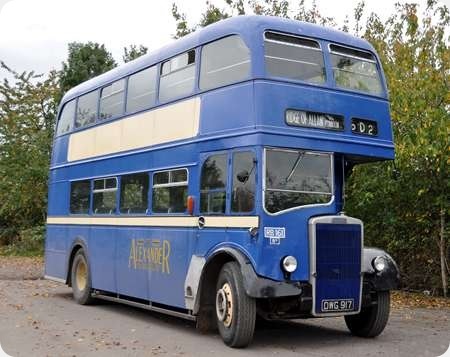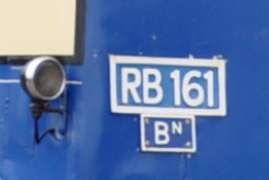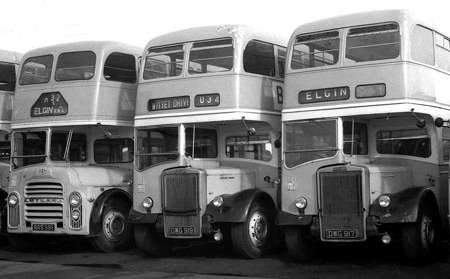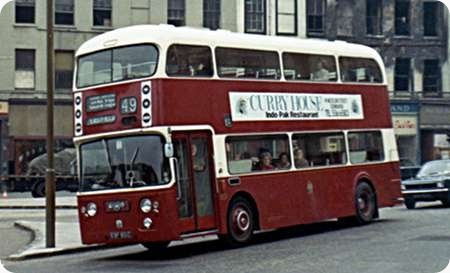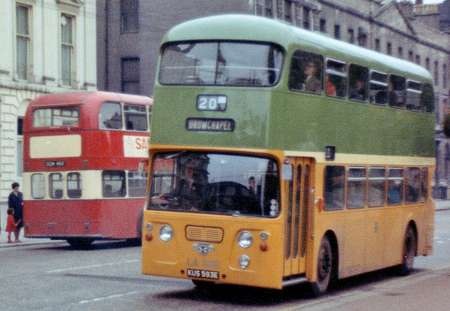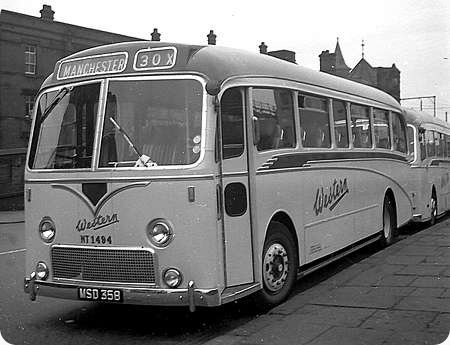
Western Scottish Motor Traction Co. Limited
1959
Bristol MW6G
Alexander C41F
MSD 358; fleet number NT1494, is a 1959 Bristol MW6G, one of 52 with Alexander C41F bodies built for Western SMT. They remained in service until 1977, which speaks volumes for the build quality of the body and chassis and the thoroughness of Western’s maintenance programme. The wheel trims on the vehicle behind would suggest that its an AEC, it has a coach door, and at the risk of splitting hairs I would say this ones folding doors and grab rails on the backs of the seats are more the type associated with a DP rather than a coach. This style of body was widely used by SMT group operators, and they were a common sight on the Newcastle to Edinburgh and Glasgow services jointly operated with United. They have a resemblance to the Park Royal bodies of the era, and I always thought they were attractive vehicle. However, unlike the later ‘Y’ type that became a common sight throughout the UK, they were never that popular South of the Border, although North Western did have a few.
Photograph and Copy contributed by Ronnie Hoye
22/05/14 – 07:27
North Western’s used the BET standard bus shell (known to Alexander as the Z type) with a straight waist-rail and equal windows throughout the length except for the very rear. Alexanders just stuck their front end (as seen on this vehicle) onto the BET spec body. North Western called them "Highlanders" and painted them in coach livery. As a coach they made a perfectly acceptable dual-purpose vehicle!
Neville Mercer
22/05/14 – 07:28
Ronnie, I think you’ll find that North Western’s examples were of the straight waistrail variant. You could almost say that this one anticipated bus grant type doors by a good few years!
Chris Barker
22/05/14 – 07:28
The North Western vehicles came in 1961as Reliances in 30 ft length with a straight window line and equal length windows plus roof quarter lights. They were followed in 1962 by the 36 ft version on the Leopard chassis.
Phil Blinkhorn
22/05/14 – 07:29
Strange to think that they also had almost identical Guys. Both were highly regarded so must simply have been a dual sourcing thing. Strictly speaking, the only English examples belonged to Barton – North Western never had any of these. What North Western DID have were standard BET bodies (built by Alexanders) but with this front grafted on. These were on Reliances and its first PSU3 Leopards. The recent book on the Y type points out that this twin flat screen design lasted into the ’80s as it was still being used on AL deckers – such as those delivered between 1973 and 1981 to STD and, later, SYPTE.
David Oldfield
22/05/14 – 14:22
Fully agree with the quality of build and good maintenance Ronnie – I recall the Guys working out of Carlisle on services to Annan as late as 1976. What struck me most about Western SMT in those days was that the vehicles were usually turned out in an immaculate condition. The fully lined out livery was also superb though it lost its edge once standard SBG fleet names replaced gold at the end of the decade.
Mike Morton
23/05/14 – 07:55
As well as Barton James Smith & Co (Wigan) Ltd and the associated Webster Bros (Wigan) both had Leyland Tiger Cub versions of this body. The six Barton Tiger Cubs were operated for over 19 years and then sold on to other operators. Now that is long service particularly as Tiger Cubs were considered by many to be too lightweight and not up to the job!
Alan Oxley
23/05/14 – 07:56
David, I think that you might have forgotten the batch supplied to Smiths of Wigan, some of which later served with Green Bus. There was also the Lancashire-registered Tiger Cub/Alexander demonstrator TTB 80 which served with Caelloi Motors in Pwllhelli before ending up with Partridge of Hadleigh (and burning out at the depot!)
Neville Mercer
23/05/14 – 13:06
I stand corrected. Thanks, chaps.
David Oldfield
26/05/14 – 09:36
Note the use of service number ’30X’. The joint Western SMT/Ribble Lancashire-Scottish services, on paper at least, carried different service numbers north and south of Carlisle. The daytime Manchester-Glasgow service was X30 in the Ribble series (and therefore the service number south of Carlisle) and 97A in the WSMT series (north of Carlisle). Maybe WSMT didn’t have letters in the first of the three ‘number’ blinds and so ‘X30′ was displayed as ’30X’. The night service was numbered X20 and 97B on the same basis.
In the summer 1964 timetable the northbound X30 took 9 hours 45 minutes end to end (9 hours 33 minutes southbound). Quite a marathon!
Can anyone tell if this photo was taken in the Manchester area? Perhaps the railway catenary at top right is a clue?
David Slater
03/06/14 – 07:35
Manchester is highly plausible, since very few places had overhead electrified railways in 1959. Manchester had two going on three (Altrincham and Sheffield, with Crewe in progress). So, taking a stab in the dark, I’d suggest the pointy building in the background is not unlike the City Road Inn at the junction of Albion Street and Whitworth Street West. That’s right beside the Altrincham line and a stone’s throw from Lower Moseley Street bus station. Though looking on Street View its hard to place the viewpoint. But so much as obviously changed around there in the intervening 55 years.
Keith
03/06/14 – 11:16
Keith has the location spot on as far as I’m concerned. This was a regular overflow parking spot for Lower Mosley St Bus Station.
Phil Blinkhorn
11/07/14 – 16:29
There was also a 1955 example of this style for Kingston Coaches on Guy Arab LUF; the furthest south this style got.
Alan Oxley will know but I think either Barton or Western SMT were the last customer for this version, Barton switching to Reliances from 1955.
By 1956 the Alexander and SOL were taking a straight waist variant.
Stephen Allcroft
13/10/15 – 06:27
I Remember Edinburgh Corporation had Coaches of this type in its City Tours Fleet. They were on Leyland chassis and looked very smart in there Black and Ivory Colours similar to Western SMTs London coaches. When they were finished with there coaching duties they were sold to Ulster at the beginning of the 1960s. Does anyone have any photos when they were with Edinburgh
George Fender
16/08/16 – 07:26
In the late 60’s, as a student, I travelled several times on the night bus from Manchester to Glasgow. I don’t know about other nights of the week, but on Fridays there were so many passengers that there were three buses. Once you were "in the know", if you were going all the way to Glasgow, it paid to turn up at Lower Moseley Street half an hour in advance of the scheduled time as the first of the three buses would leave early and full and only stop at Penrith for toilets and the all-night cafe. The first time I made the journey, I was on the third bus, which left at the advertised time and stopped everywhere, of course getting to Penrith just after a lot of other buses going north and south so the queue at the cafe was just too long to contemplate. As I remember it, though, even the third bus would arrive at Glasgow much earlier than timetabled.
Malcolm Wood
